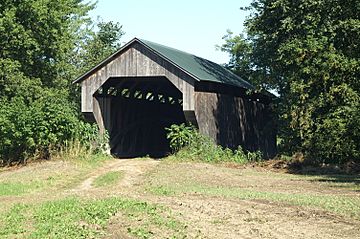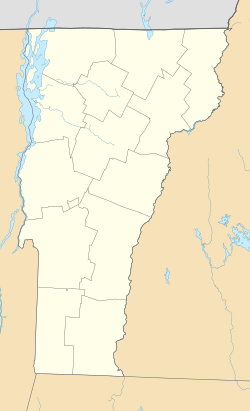Gates Farm Covered Bridge facts for kids
Quick facts for kids Gates Farm Covered Bridge |
|
|---|---|

Bridge in U.S. state of Vermont
|
|
| Carries | Farm equipment |
| Crosses | Seymour River |
| Locale | Cambridge, Vermont |
| Maintained by | private owner |
| ID number | VT-08-04 |
| Characteristics | |
| Design | Covered, Burr arch |
| Material | Wood |
| Total length | 60 ft (18.3 m) |
| Number of spans | 1 |
| History | |
| Constructed by | George W. Holmes |
| Construction end | 1897 |
| Location | Off VT 15, over Seymour River, Cambridge, Vermont |
| Area | 1 acre (0.40 ha) |
| NRHP reference No. | 74000223 |
| Added to NRHP | November 19, 1974 |
The Gates Farm Covered Bridge is a special kind of bridge in Cambridge, Vermont. It's a covered bridge, meaning it has a roof and walls, and it crosses the Seymour River. This bridge was built a long time ago, in 1897. It's important because it was one of the last bridges built using a design called the Burr arch during a time when many covered bridges were being made. In 1974, it was added to the National Register of Historic Places, which means it's recognized as a historic landmark.
Contents
What is the Gates Farm Covered Bridge?
The Gates Farm Covered Bridge is found a little bit east of the main town of Cambridge. It sits on a farm property, just south of Route 15. The bridge goes from east to west over the Seymour River. This river is a smaller stream that flows into the Lamoille River.
The bridge is 82.5 feet (25.1 m) long and 19.5 feet (5.9 m) wide. Its roadway, where vehicles drive, is 16 feet (4.9 m) wide. It has a metal roof with a pointed top, like a house roof. The bridge rests on strong concrete supports called abutments.
The outside of the bridge is covered with wooden boards placed up and down. These boards stop before the roof, leaving a small open space near the top. The wooden covering also extends a short way inside the entrances. The floor of the bridge is made of wooden planks.
History of the Gates Farm Covered Bridge
This bridge was built by a person named George W. Holmes in 1897. It is one of only nine bridges left in Vermont that use the special Burr arch design. This design combines a strong arch with a truss system, making the bridge very sturdy.
The bridge was first called the "Little Covered Bridge." It was originally located a few hundred feet downstream from its current spot. Back then, it carried Route 15 and was near the longer Cambridge Covered Bridge.
Why the Bridge Moved
In 1950, something interesting happened. The Seymour River's path was changed. It used to flow into the Lamoille River further upstream. But after the change, it emptied into the Lamoille River downstream of the Cambridge Bridge. This meant the "Little Bridge" was no longer needed for the highway.
However, the Gates family farm became separated from its fields by the river's new path. To help the farmers get to their fields, the "Little Bridge" was moved. It was placed over the new course of the Seymour River on the Gates farm property. That's when it got its new name, the Gates Farm Covered Bridge.
It's also interesting to know that the Cambridge Covered Bridge, which was nearby, was also moved. It became the Shelburne Museum Covered Bridge.
Bridge Restoration
After many years, by 1994, the Gates Farm Covered Bridge started to show signs of wear and tear. Because it was in a flood-prone area, it suffered damage and was taken off its supports.
But don't worry, the bridge was saved! In 1995, it was carefully restored. During this restoration, the inside height of the bridge was made 18 inches (0.46 m) taller. This change allowed larger farm equipment to pass through the bridge more easily, which was very helpful for the Gates family farm.



